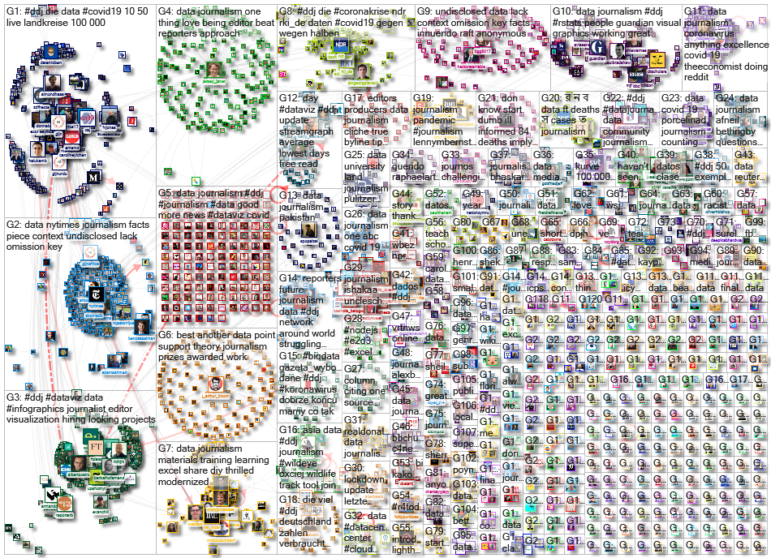Economies around the world have taken a big hit as countries implement lockdown measures to curb the spread of the coronavirus. Our NodeXL #ddj mapping from May 4 to 10 finds The New York Times looking into businesses that could be potential infection super-spreaders and the alarmingly high unemployment rate. Elsewhere, researchers from several US institutions created an economic activity tracker to show the impact of the lockdown, and German news media NDR and ZDF heute examined lost life expectancy due to COVID-19 and the importance of intensive care beds. Reuters, meanwhile, published an important analysis into the use of a little-known law increasingly used to grant immunity to cops who use excessive force.
Safer to Visit a Cafe or a Gym?
When governments start to deliberate relaxing COVID-19 lockdown restrictions, there are things to consider: Which businesses carry a lower infection risk and should be reopened first? And which places are safer for people to visit? To determine which businesses or locations could potentially be infection “super-spreaders,” several profs at the University of Chicago analyzed anonymized cellphone location data, and asked people to rate places by the frequency of interaction with people or contact with surfaces.
Economists deploy data science against COVID-19 by Katherine Baicker, Oeindrila Dube, @M_Sendhil @DevinGPope and Gus Wezerek https://t.co/pE2v4exSKR
— William Easterly (@bill_easterly) May 10, 2020
US Unemployment “Off the Charts”
“What would typically take months or quarters to play out in a recession happened in a matter of weeks this time,” commented Michelle Meyer, head of US economics at Bank of America, on the devastation that COVID-19 has wrought on American jobs. She’s quoted alongside The New York Times’ creative visualization of the availability of jobs plunging the entire length of its print edition (and drawing much attention on Twitter). Read the story here.
Tomorrow’s @nytimes tonight:
U.S. Unemployment Is Worst Since Depression#nytimes pic.twitter.com/lx4jWHhVZq
— Tom Jolly (@TomJolly) May 9, 2020
Economy Tracker for COVID-19
A new tracker that measures real-time economic activity in the US was created through a collaboration among Harvard University, Brown University, research institute Opportunity Insights, and Darkhorse Analytics. Using anonymized data from private businesses, the tracker includes statistics on consumer spending, employment rates, incomes, business revenues, job postings, and other key indicators to measure the economic impact of COVID-19.
This incredible economic tracker by @OppInsights is the most comprehensive and reliable tool looking at the economic impact of #COVID19 to date. I've had the chance to see @michaelstepner work very hard on this and it's clearly paid off:
https://t.co/HX6bpbpgYT pic.twitter.com/gmbhwvVfzY— Bhuvana (@bhuvana_rai) May 7, 2020
Immunity for Police Violence
Journalists at Reuters spent more than a year looking into a little-known legal defense called “qualified immunity” that was created to protect US government employees from frivolous litigation. Reuters’ review of cases from 2015 to 2019 revealed that the courts had an increasing tendency to grant immunity in cases where police had used excessive force. Journalist Andrew Chung explained the story in this Twitter thread, while data journalism editor Janet Roberts gave some behind-the-scenes insights here. There’s more on how Reuters analyzed the data here.
SPECIAL REPORT: Enabled by the Supreme Court, cops are increasingly evading accountability in excessive force cases thanks to the legal defense known as QUALIFIED IMMUNITY. Part one of our data-driven @Reuters investigation: https://t.co/aNGKLheCz2
— Lawrence Hurley (@lawrencehurley) May 8, 2020
Where’s the Scale?
Alberto Cairo, Knight Chair in Visual Journalism at the University of Miami, noticed that removing scales from graphics seems to be getting more popular among data journalists. He blogs about the potential problems of readers misinterpreting such graphs.
New post: The problem with unlabeled scales https://t.co/alifLCl1Of #dataViz #infographics #ddj pic.twitter.com/1yiOkfXu8p
— Alberto Cairo (@AlbertoCairo) May 7, 2020
Best Pandemic Data Journalism
British media trade magazine Press Gazette compiled a list of what it considers to be the best data journalism on the coronavirus pandemic so far. It includes excellent work by the Financial Times, the Guardian, the South China Morning Post, and others.
The coronavirus pandemic is the biggest story of our lives and it has largely been told through data. Here are some of the best examples of data journalism to come out of the crisis so far as highlighted in our Coronavirus Journalism Excellence survey https://t.co/Vs5e23nH3W
— Press Gazette (@pressgazette) May 7, 2020
Comic: Data Errors
Statistical hypothesis testing can be error-prone. xkcd creator Randall Munroe — who once worked on robots at NASA’s Langley Research Center in Virginia — created his own list of errors in a hilarious comic. Hint: Look out for error type IX.
This list of errors is a list of my data journalism nightmares: https://t.co/s5KYK5qAPp
— Kate Martin (@KateReports) May 7, 2020
Lost Life Expectancy Due to COVID-19
Opponents of COVID-19 lockdown restrictions often make the argument that the virus is only a danger to individuals who are already very old and sick, and therefore would only have a short life expectancy anyway. German broadcaster NDR decided to look into that claim. Its analysis showed that many of those who died from the virus could have expected to live for a long time, up t0 10.7 years for men and 9.3 years for women.
Von wegen "in einem halben Jahr sowieso tot"! #Covid19-Tote hätten noch 9 Jahre zu leben gehabt – trotz Vorerkrankungen. Unsere @ndr-Datenanalyse zeigt, wie sehr @ob_palmer die #Coronakrise verharmlost. #ddj hilft gegen Politiker-#FakeNews!https://t.co/YeQNTcvUjK
— Björn Schwentker (@BSchwentker) May 8, 2020
Tracking Hospitalizations
Nonprofit newsroom CalMatters is extensively tracking hospitalizations across California. The group is recording by county the number of people who have tested positive for COVID-19, and those suspected of having the disease.
We're tracking hospitalizations in California of people who have tested positive for the disease caused by the novel coronavirus or who are suspected of having #COVID19. https://t.co/8YaDlwDCYf#californiacoronavirus #californialockdown #californiashutdown
— CalMatters (@CalMatters) April 5, 2020
Importance of Intensive Care Beds
The question comes up again and again in this global health crisis: Are there enough intensive care beds for critically ill COVID-19 patients? German news program ZDF heute looked into the occupancy rate of ICU beds across the country. It also visualized the number of new infections in the last seven days per 100,000 inhabitants in this piece.
Unbedingt anschauenswert:
die Intensivbettenlage und das Kliniksterben mit interaktiver Karte, starken Erklärgrafiken und Gesprächspartner*innen
🚀 #ddj von @datenrobert & @simondhaas https://t.co/NZtwla6tck pic.twitter.com/m6EHl6AEAl
— Frederic Huwendiek (@Huwendiek) May 7, 2020
Thanks again to Marc Smith of Connected Action for gathering the links and graphing them. The Top Ten #ddj list is curated weekly.
 Eunice Au is GIJN’s program coordinator. Previously, she was a Malaysia correspondent for Singapore’s The Straits Times, and a journalist at the New Straits Times. She has also written for The Sun, Malaysian Today, and Madam Chair.
Eunice Au is GIJN’s program coordinator. Previously, she was a Malaysia correspondent for Singapore’s The Straits Times, and a journalist at the New Straits Times. She has also written for The Sun, Malaysian Today, and Madam Chair.

